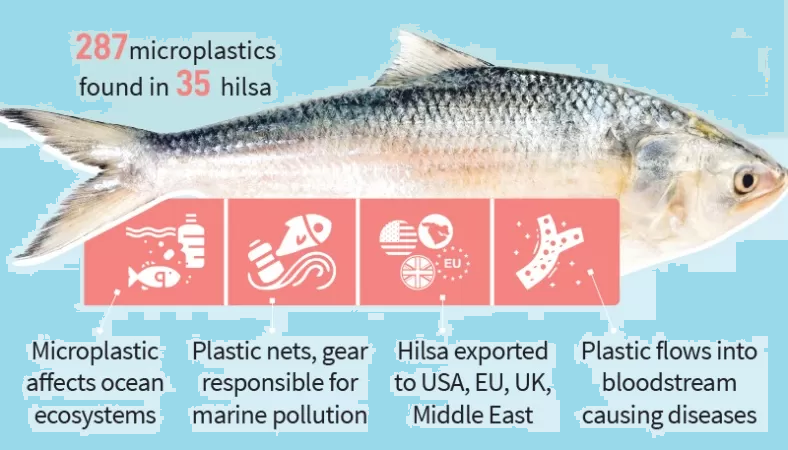
Consuming hilsa may turn disastrous

People consume microplastics (MPs) as they eat national Hilsa fish, one of the vital natural protein supplies from the Bay of Bengal.
Researchers found a total of 287 MPs from 35 Hilsa fish which were collected as samples from Meghna River in Lakshmipur and Noakhali between July and September 2020.
Meghna is a vital aquatic resource of hilsa. In the samples 30 per cent dominant colour of polymers was transparent, grey 26 per cent and black 23 per cent.
Fibre was the most dominant shape of observed MPs in the maximum number of 300-1500 micron size class.
Researchers fear that microplastics affect the ocean ecosystems, livelihoods and sustainable development and badly impact the human body.
A research team of the Department of Oceanography, Noakhali Science and Technology University (NSTU), headed by Mohammad Abdul Momin Siddique found this microplastic contamination in Bangladesh.
The research aimed to identify, classify and quantify MPs ingested by the national fish.
Hilsa fish is ingesting MPs when it migrates in the river and estuaries from the ocean for feeding, swimming, and spawning purposes.
The plastic is injected into the human body but the government is careless to stop this manmade contamination, Mohammad Abdul Momin Siddique told The Business Post.
He said MPs are considered plastic pieces of 5mm (5000 microns) in size or less. They cannot be seen without a lab test.
People consume it directly and it makes hyaluronic acid (HA) in the human stomach. Then the plastic flows into the human bloodstream. It may cause diseases.
Environmentalists say MPs consist of manufactured raw plastic materials that enter the ocean via a draining system from personal care and cosmetics products and washing clothes.
Aquaculture activities, fishing gears and ropes, foams used in fishing boats, seafood market materials and styrofoam buoys are significant sources of MPs. It also enters the river or sea from larger plastic sources.
Experts say fishermen using plastic nets and gear are responsible for marine pollution but they are overfishing due to vulnerability to climate change.
This reporter recently visited the Meghna River of coastal district Bhola and found fishing nets being sewn on the bank of the river while abandoned plastic nets and fishing gear being washed away into the river.
Fisherman Sirajul Islam said they had been doing it for a long time but didn’t know that it was the cause of pollution.
South Asia is the third-largest contributor to global plastic waste and generates 334 million metric tonnes of solid waste every year.
Nearly 12 per cent of 70 to 80 per cent of this waste ending up in the ocean is plastic. Bangladeshi rivers act like express highways for plastics carried to the oceans, the World Bank report said.
MPs such as polyvinyl chloride, polyester or polyamide with high specific density accumulate in the sea while low-density MP items such as polypropylene and polyethene dominate the sea surface.
Dr Md Mostafizur Rahman, Associate Professor of Jahangirnagar University told The Business Post that animal or human bodies cannot carry plastic granule and it is not digested. It causes diseases after staying in human body for a long time.
There is no alternative to stopping it, he added.
Hilsa species are widely found during the tidal rhythms in the Bay of Bengal. Bangladesh enjoys an 86 per cent share followed by India that enjoys 8 per cent share, Myanmar 4 per cent while other countries share the rest.
During the migration, they intake food and water contaminated by MPs. It could be accumulated in the gastrointestinal tract, flesh and other parts.
“We are conducting mobile courts against illegal plastic net. But it is hard to stop multiple items of contamination from different sources,” Khandaker Mahbubul Haque, Director General of Fisheries Department, told The Business Post.
He said the Fishing Department would launch an awareness campaign programme on the issue for fishermen.
According to the DoF, around 6, 0000 Bangladeshi fishermen are directly catching Hilsa fish and many others are involved with ancillary activities, including fishing net and boat making, ice production, processing and export.
It contributes 12 per cent to the total fish production and 1.15 per cent to the GDP. It also contributed about 86 per cent to the global Hilsa production in Bangladesh, a DoF report said.
Hilsa is exported to the USA, EU, UK and the Middle East targeting Bangladeshi expatriates.
Editor & Publisher: S. M. Mesbah Uddin
Published by the Editor from House-45,
Road-3, Section-12, Pallabi, Mirpur
Dhaka-1216, Bangladesh
Call: +01713180024 & 0167 538 3357
News & Commercial Office :
Phone: 096 9612 7234 & 096 1175 5298
e-mail: financialpostbd@gmail.com
HAC & Marketing (Advertisement)
Call: 01616 521 297
e-mail: tdfpad@gmail.com